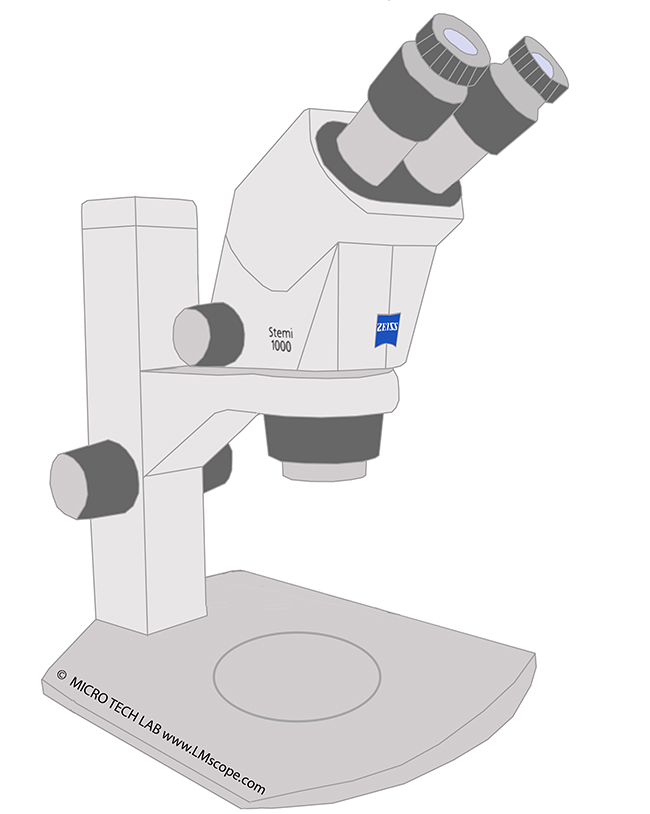

Zeiss Stemi 1000: add powerful digital cameras to the microscope eyepiece tube with our LM adapter solutions
The Zeiss Stemi 1000 is a binocular Greenough-type stereo microscope that doesn’t have a phototube. It is suitable for a wide range of applications, such as geology, quality control, biology and medicine, and its affordable price also makes it a good alternative for hobbyists. The Stemi 1000 was produced between 1998 and 2008.

Overview of key technical specifications:
- Greenough-type stereo microscope (13 degrees)
- Zoom factor 5:1
- Magnification range 7x–35x (expandable)
- Working distance max. 112mm
- Field of view max. 21mm
- Illumination: transmitted light and reflected light
- Weight with small stand: approx. 6kg
- Eyepiece tubes: 30mm ID
Because it features a modular design, the Stemi 1000 can be customised with a variety of stands, eyepieces of different magnifications with measurement and grid inlays, as well as lighting options.
Lighting options include reflected light illumination with halogen or cold light lamps, available in ring light or gooseneck styles in addition to directly integrated illumination. The microscope also accommodates a selection of filters (colour filters, polarisation filters, neutral density filters, etc.), and transmitted light and polarisation units are available as well.
The standard version of the microscope comes with a 1x objective lens, resulting in a total magnification range of 7x to 35x and an object field diameter of 21mm. Compared to microscopes in the same price range, these figures are relatively modest. In addition to the 1x objective lens, the following supplementary lenses are also available: 0.3x, 0.4x, 0.63x and 2x. To easily reproduce magnifications, the microscope has click-stops at three different magnification levels (1x, 2x and 4x). The maximum magnification achieved with a 10x eyepiece and a 2x objective lens is thus 70x.
As mentioned previously, the Stemi 1000 is a binocular microscope, meaning it does not come with a phototube. However, it is still possible to add a modern digital camera with a large sensor to this microscope. The eyepiece tubes have a standard internal diameter of 30mm.

With our flexible adapter solutions, featuring high-quality precision optics, it is possible to attach the camera to the eyepiece tube of the microscope, which has a 35 degree viewing angle. To do this, one eyepiece is removed and the camera-adapter combination is put into its place.

Different adapter versions are also available for the eyepiece tubes. Depending on the specific requirements (field size, magnification, focusing capability, option to add filters, etc.), a customised adapter system will be assembled for you.
Please get in touch to let us create an offer that perfectly suits your needs.
Modern mirrorless system cameras and DSLRs are the preferred choice for working with stereo microscopes. Their sensors are significantly larger, more powerful and light-sensitive and deliver high-quality images.
A high number of pixels is also a plus, especially at lower magnifications. Additionally, these cameras can be conveniently controlled from a computer and connected to a large monitor with an HDMI cable.
Conclusion: The Zeiss Stemi 1000 is a versatile and user-friendly microscope that can be equipped with high-quality camera systems by attaching them to the eyepiece tube. For users who prefer to have both eyepieces available for visual observation, we recommend a microscope with a separate phototube, such as the Zeiss Stemi 2000C , Zeiss Stemi 305 , Zeiss Stemi 508 or Motic SMZ171.
04.03.2025Photography:
Fitting the microscope to digital single-lens reflex (DSLR), mirrorless interchangeable-lens cameras (MILC ), digital single-lens mirrorless (DSLM) or C-mount cameras is easy with our LM digital SLR adapters, which feature a plan achromatic optical system. Our products make it possible to capture top-quality microscope images. To help you select the adapter that is right for your camera, we have set up an online configurator on our website. You can also email us – ideally with attached photographs of your microscope.
Modern DSLR and single-lens mirrorless (DSLM) offer the latest technology and are generally very well suited for microscopy applications. Most of them can be controlled remotely via PC/Mac. Because of their high sales volumes, they offer an excellent price/performance ratio compared to special-purpose microscope cameras.
Features of top DSLR and single-lens mirrorless cameras (DSLM):
- Large, powerful full-frame sensors (36 x 24 mm)
- Sensor resolution of 61 megapixels or 240 megapixels with Pixel Shift technology
- High light sensitivity (ISO 400,000+)
- Extensive dynamic range (up to 15 aperture stops/f-stops)
- Short exposure times (1/8000 second) up to 1/32,000 seconds using the digital shutter
- 4K Ultra HD or 8K Ultra HD video function
- Live video capture on external monitors in ultra HD quality
In most cases, these cameras are significantly more powerful than microscope cameras with smaller sensors (1/2" or 2/3"). On our website you will find our current camera recommendations and a camera ranking which is specifically tailored to microscopy applications.